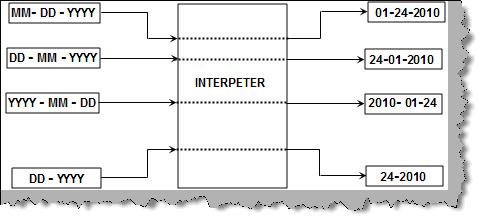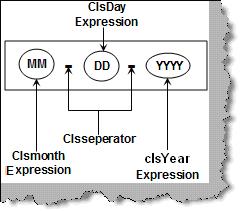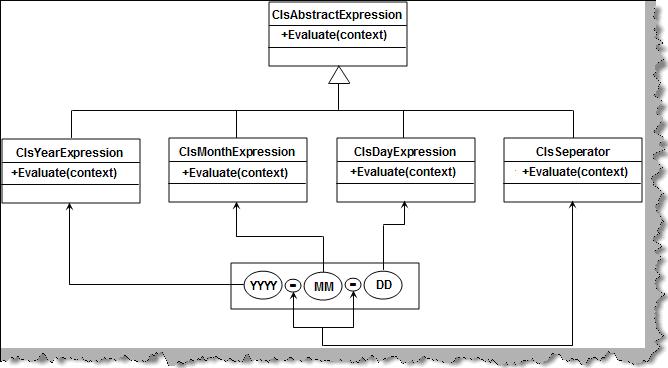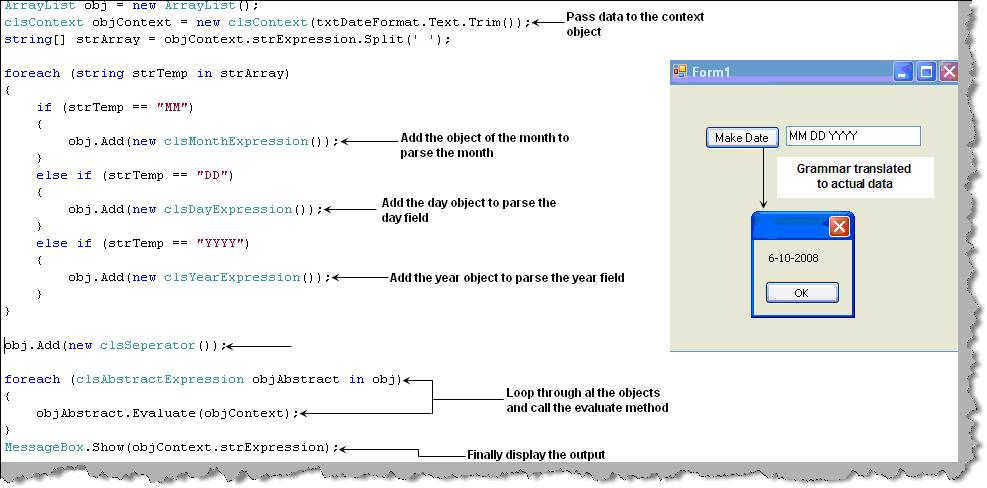Interpreter pattern allows us to interpret grammar in to code solutions. Ok, what does that mean?. Grammars are mapped to classes to arrive to a solution. For instance 7 – 2 can be mapped to ‘clsMinus’ class. In one line interpreter pattern gives us the solution of how to write an interpreter which can read a grammar and execute the same in the code. For instance below is a simple example where we can give the date format grammar and the interpreter will convert the same in to code solutions and give the desired output.
 Figure: – Date Grammar
Figure: – Date Grammar
Let’s make an interpreter for date formats as shown in figure ‘Date Grammar’. Before we start lets understand the different components of interpreter pattern and then we will map the same to make the date grammar. Context contains the data and the logic part contains the logic which will convert the context to readable format.
 Figure: – Context and Logic
Figure: – Context and Logic
Let’s understand what is the grammar in the date format is. To define any grammar we should first break grammar in small logical components. Figure ‘Grammar mapped to classes’ show how different components are identified and then mapped to classes which will have the logic to implement only that portion of the grammar. So we have broken the date format in to four components Month, Day, Year and the separator. For all these four components we will define separate classes which will contain the logic as shown in figure ‘Grammar mapped to classes’. So we will be creating different classes for the various components of the date format.
 Figure: – Grammar mapped to classes
Figure: – Grammar mapped to classes
As said there are two classes one is the expression classes which contain logic and the other is the context class which contain data as shown in figure ‘Expression and Context classes’. We have defined all the expression parsing in different classes, all these classes inherit from common interface ‘ClsAbstractExpression’ with a method ‘Evaluate’. The ‘Evaluate’ method takes a context class which has the data; this method parses data according to the expression logic. For instance ‘ClsYearExpression’ replaces the ‘YYYY’ with the year value,’’ClsMonthExpression’ replaces the ‘MM’ with month and so on.
 Figure :- Class diagram for interpreter
Figure :- Class diagram for interpreter
 Figure: – Expression and Context classes
Figure: – Expression and Context classes
Now that we have separate expression parsing logic in different classes, let’s look at how the client will use the iterator logic. The client first passes the date grammar format to the context class. Depending on the date format we now start adding the expressions in a collection. So if we find a ‘DD” we add the ‘ClsDayExpression’, if we find ‘MM’ we add ‘ClsMonthExpression’ and so on. Finally we just loop and call the ‘Evaluate’ method. Once all the evaluate methods are called we display the output.
 Figure: – Client Interpreter logic
Figure: – Client Interpreter logic
hi,
really nice information, very helpful.
here check this out, wondering if someday you need some Indonesian Transcription.
yhanks